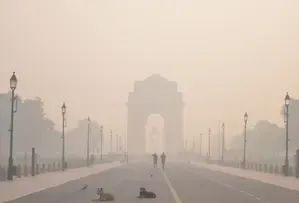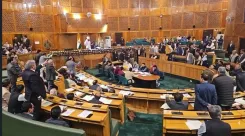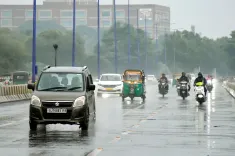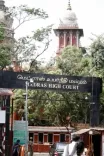Is Delhi's Air Quality Deteriorating Again?

Synopsis
Key Takeaways
- Delhi's AQI has entered the 'very poor' category.
- Wazirpur and Mundka recorded alarming AQI levels.
- Several NCR cities are experiencing poor air quality.
- Dust storms and strong winds have contributed to the decline.
- Health authorities advise vulnerable populations to limit outdoor activities.
New Delhi, May 16 (NationPress) The air quality in Delhi plunged into the “very poor” category this Friday morning, recording an average Air Quality Index (AQI) of 305. Notably, areas like Wazirpur and Mundka experienced even more severe conditions with AQI levels skyrocketing to 422 and 419, respectively, as reported by the Central Pollution Control Board (CPCB).
This deterioration follows a period of dust-laden winds and adverse atmospheric conditions impacting the National Capital Region (NCR) ahead of the monsoon season.
Data from the CPCB indicates that multiple cities within the NCR reflected similar poor air quality. Gurugram recorded an AQI of 294, Faridabad at 288, Ghaziabad at 283, Greater Noida at 256, and Noida at 289, all categorized as “poor” to “very poor”.
In Delhi itself, alarming pollution levels were detected in various localities. The most affected were Wazirpur and Mundka, where AQI reached 422 and 419, respectively, placing them in the “severe” category. A total of 21 areas in the national capital reported AQI readings between 300 and 400, highlighting the widespread air quality crisis.
Noteworthy locations such as Anand Vihar (362), DTU (365), Dwarka Sector 8 (388), Jahangirpuri (353), Siri Fort (355), and Ashok Vihar (328) recorded critically high pollution levels.
Meanwhile, 12 other areas, including Bawana (289), Lodhi Road (277), IGIA (240), Najafgarh (271), RK Puram (265), and Burari Crossing (243), reported AQI figures in the “poor” category, falling between 200 and 300.
The worsening air quality is partially attributed to a sudden surge of dust and strong winds that swept through the city on Wednesday night.
The India Meteorological Department (IMD) noted that a moving cloud mass over the region generated strong winds at speeds of 30–40 km/h, especially in the Palam area. These winds stirred up fine dust particles, significantly degrading air quality and visibility across Delhi.
An IMD official indicated that visibility dropped from 4,500 meters to a mere 1,200 meters in less than two hours. As thick haze enveloped the city on Thursday morning, residents experienced diminished visibility alongside a stark decline in air quality.
Officials have recommended that individuals, particularly children, the elderly, and those with respiratory issues, avoid outdoor activities and wear protective gear when venturing outside.









